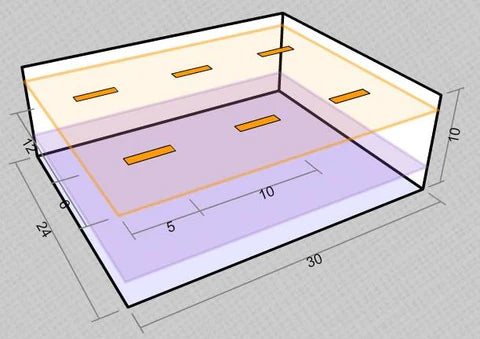
How Many Lights do I Need for a 40' ft. X 60' ft. Pole Barn Shop?
Share
Lighting a shop of that size requires careful planning to ensure proper illumination and energy efficiency. Here's a general guideline on how to light up a 40' x 60' x 20' tall shop:
Alamo Lights can save you time with our simple calculator:
-
Calculate Lighting Requirements: Determine the total square footage of the shop. In this case, it's 40' x 60' = 2400 square feet. For general task lighting in a shop, you'll want around 50 lumens per square foot. So, for a 2400 square foot shop, you'll need 2400 * 50 = 120,000 lumens in total.
-
Choose Lighting Fixtures: Select lighting fixtures that are appropriate for the space and your lighting needs. LED fixtures are often the best choice due to their energy efficiency and longevity. High bay LED lights are suitable for the high ceiling of your shop.
-
Layout Design: Determine the layout of the lighting fixtures. Aim for uniform lighting distribution across the entire space to minimize shadows and provide adequate illumination for various tasks. Consider the placement of workstations, machinery, and storage areas when planning the layout.
-
Mounting Height: Since your shop has a tall ceiling (20 feet), you'll need fixtures specifically designed for high ceilings. Make sure the fixtures are mounted at an appropriate height to provide optimal lighting without creating glare or hotspots.
-
Spacing: Space the fixtures evenly throughout the shop to ensure uniform lighting. The spacing will depend on the lumen output and beam angle of the fixtures you choose. Typically, fixtures should be placed every 10-15 feet for even coverage.
-
Lighting Zones: Divide the shop into lighting zones if different areas have varying lighting needs. For example, workstations may require brighter lighting than storage areas.
-
Lighting Controls: Install lighting controls such as dimmers, timers, or motion sensors to increase energy efficiency and customize lighting levels based on occupancy and time of day.
-
Natural Light: Utilize natural light sources such as windows or skylights where possible to reduce reliance on artificial lighting during daylight hours.
-
Professional Installation: If you're not experienced with electrical work, hire a professional electrician to install the lighting fixtures safely and according to local building codes.
-
Evaluate and Adjust: Once the lighting is installed, evaluate the illumination levels and make any necessary adjustments to ensure optimal lighting conditions for your specific tasks and preferences.
PrimeLights fixture calculator.
By following these steps, you can effectively light up your 40' x 60' x 20' tall shop for maximum visibility and productivity.
